2024 Jeep Wrangler First Drive Review: More comfortable, most capable

Jeep has gone through four generations in 38 years of the Wrangler nameplate. The inaugural YJ (square headlights) replaced the CJ line, then morphed into the TJ (correct headlights) that introduced coil springs, then the JK and its four-door Unlimited model, and finally to today's JL that has been on sale since 2018. Each time, Jeep engineers were tasked with two disparate goals: make the Wrangler more capable and also more comfortable.
The 2024 Jeep Wrangler (2024 below right in blue) is a heavily revised version of the JL (2023 below left in silver). It’s a refinement — a rejiggering of trims and powertrains and the introduction of the nicest interior in Wrangler history, all intended to keep Jeep in front of current and upcoming competition. Suffice it to say that the product is better now than ever before. And, of course, more expensive too.
No matter which Wrangler model you’re after, the biggest usability upgrades for 2024 are inside (you can see the differences below). While the previous Wrangler’s dash looked chunky and playful, the new version is more refined. Each trim gets unique highlights and materials, some in cloth and some in a mixture of faux and real leather. Highlights include the Mantis Green of the High Altitude and the deep red inside the 392. Side curtain air bags are not only available for the first time, they are standard.
The most obvious change inside is a 12.3-inch horizontally oriented touchscreen that’s standard across the board. The latest Android-based Uconnect software package is very good, with large icons that are easy to locate, snappy performance and over-the-air updates to keep it up to date. Wireless Apple CarPlay and Android Auto are supported along with Alexa Home to Car. An improved voice recognition system now features microphones around the cabin.
The big screen runs a new Trails Offroad application that comes preloaded with a couple hundred adventure guides that help users find and navigate trails all across the United States. A route description, difficulty ratings, waypoints, obstacles and points of interest make choosing trails an easier task, and if that fails, owners can create their own in the software. A premium subscription unlocks access to more than 3,000 maps. We found the Trails Offroad app very easy to use and appreciated its seamless integration into the infotainment and mapping tech. It’s a solid effort that offers Jeepers options to find places near them to put their vehicles to use.
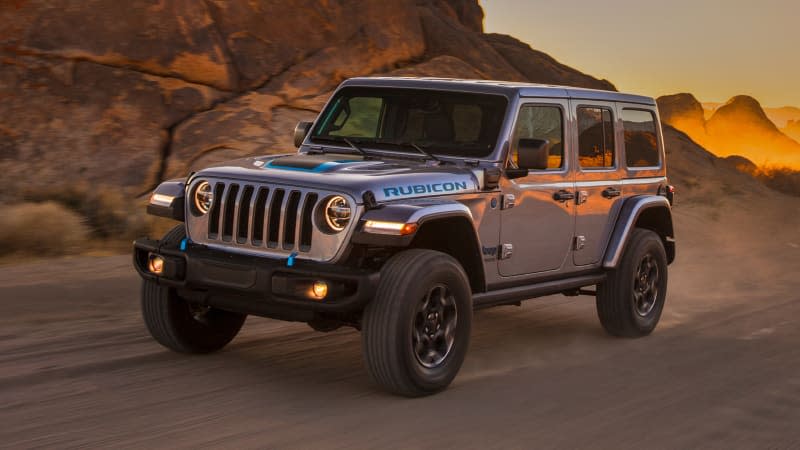
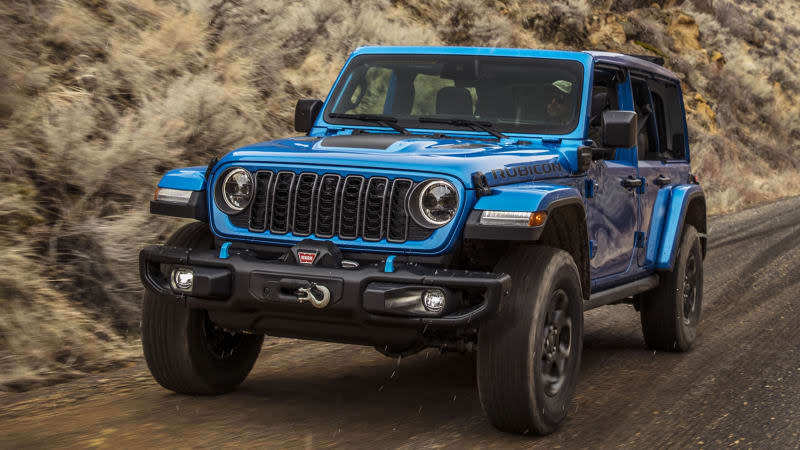
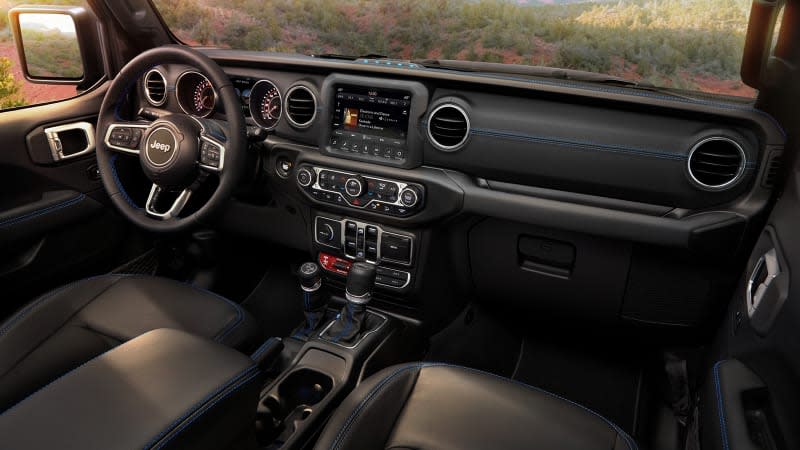
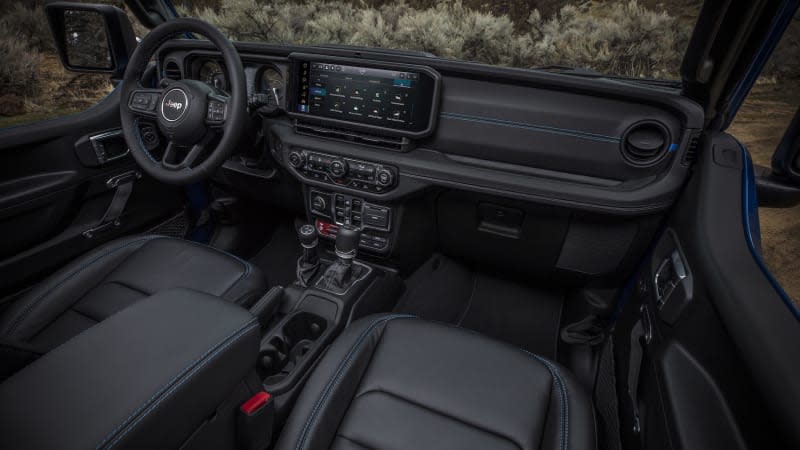
The 2024 Wrangler line kicks off with the base Sport model, adds some equipment with the Sport S and, for the new model year, an upgraded Willy’s that gains off-road goodies previously held for Rubicon and company. The Sahara and High Altitude are street-oriented offerings with comparatively high equipment levels. Then there’s the popular Rubicon off-road model and the new-for-2024 Rubicon X that combines all the best off-road and luxury bits in one package.
And then there’s the berserk Wrangler Rubicon 392 (below in Anvil gray with red leather) with its 6.4-liter V8 spinning out 470 horsepower and a matching 470 pound-feet through a heavy-duty eight-speed automatic. It does 0-60 in 4.5 seconds and covers the quarter mile in 13 flat but feels even quicker due to its towering height — the Xtreme 35 package (previously “xTreme Recon”) is standard, which adds, as its name implies, 35-inch tires and a small lift.
From behind the wheel, the 392 is beastly in the best way possible and feels like the world’s most absurd muscle car on stilts. Its wide stance means it’s planted on the highway, even at high speed, but steering on all Wranglers can be a bit … imprecise, to be kind, and the speeds that the 6.4-liter V8 encourages exacerbate that tiller-and-rudder feeling. Around town, things are more settled. A quick stab of the throttle equals immediate thrust and a correspondingly immediate thunder from the four downward-tilted exhaust pipes behind the rear wheels.
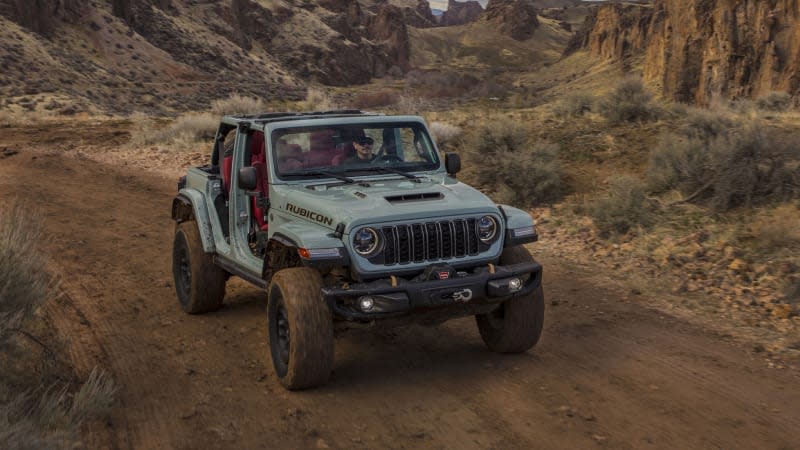
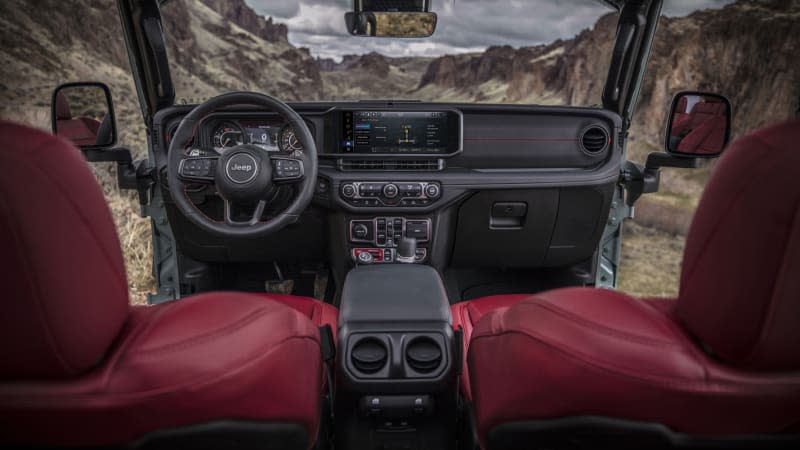
Most buyers will be looking at one of the more mundane powerplants. We’re fond of the plug-in hybrid Wranger 4xe that boasts 375 hp (and so is America as it's the best-selling plug-in hybrid). There’s enough power in the 17.3-kWh lithium ion battery pack to provide an estimated 21 miles of electric range, and we found that to be an accurate average figure. While that may not be enough for a full day, it does contribute to a much more efficient package that will save its owners money on fueling bills. And with its V8-matching 470 lb-ft of torque, the 4xe strikes a solid balance between efficiency and acceleration. For 2024, Jeep added a Power Box with four 120-volt outlets with 30 amps of total output so owners can use the battery pack to power external devices. We saw it in action powering a large flatscreen television (hmm, now where have we seen that before?).
The 3.6-liter Pentastar V6 is a known quantity, and with 285 hp, it remains a reasonable choice. It’s also the only way to get a six-speed manual transmission. The optional 270-hp 2.0-liter turbocharged four gets an eight-speed auto standard and is a bit quicker and more efficient than the base six, but while it offers more torque (295 lb-ft vs. 260 lb-ft) it doesn’t feel like a serious performance-minded upgrade.
There’s a similarly long list of four-wheel-drive systems. Command-Trac uses a traditional part-time transfer case with 2WD High, 4WD High and 4WD Low modes. Locked in Low, it delivers a 2.72:1 crawl ratio. Next up is the Selec-Trac system, which is standard on the 392, optional on the Sport and Sahara, and adds a 4WD Auto mode for full-time use regardless of driving surface. The Rubicon’s Rock-Trac system delivers an excellent 4.0:1 Low range, which equals a crawl ratio is as low as 100:1 with the right packages.

 Yahoo Autos
Yahoo Autos 
